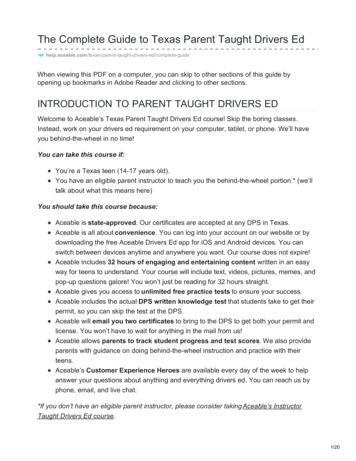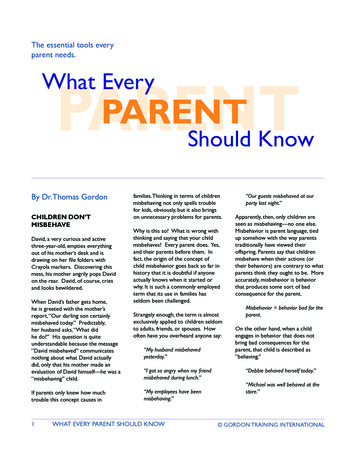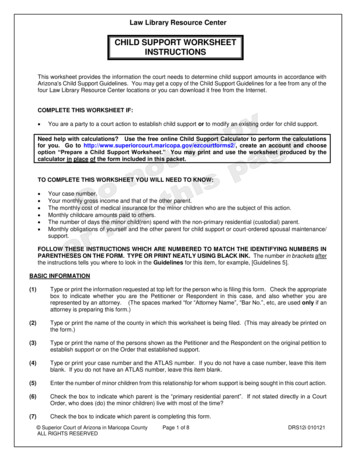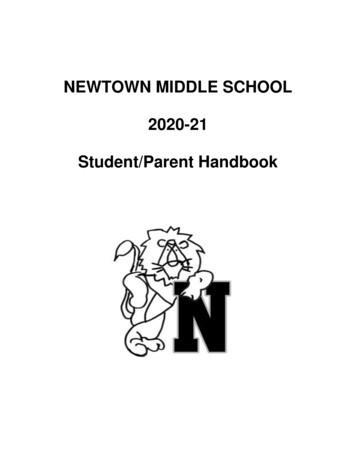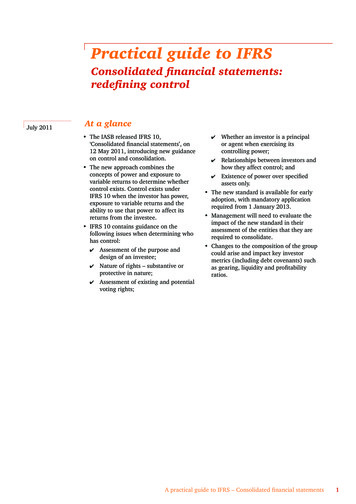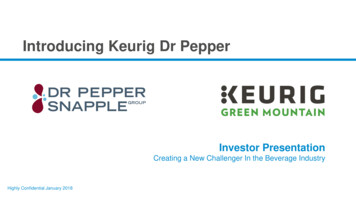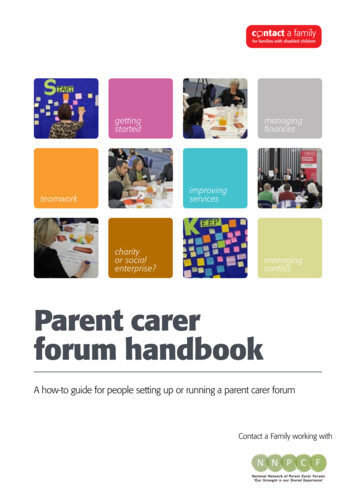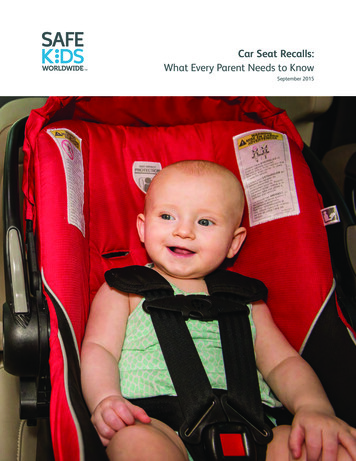
Transcription
Car Seat Recalls:What Every Parent Needs to KnowSeptember 2015
Registering your child’s car seat is the best way for the manufacturerto alert you of a recall and send you any required repair kit.WHAT YOU NEED TO KNOWWHAT YOU NEED TO DOIt’s easy. Register your car seat today.80%42%ONLINEABY M IL– OR –80% of parents surveyed said that thecar seat registration card is important,but only 42% returned the card.Register on your carseat manufacturer’swebsite. You’ll need themodel number anddate of manufacturefound on a label onyour car seat.Fill out and mail theregistration card thatcame with your carseat. It already includesyour car seat’s information. No postagerequired.If there is a recall, act!6 millionIn 2014, more than six million car seats wererecalled for a safety defect, yet fewer than halfof them were fixed.If your car seat has been recalled, make anynecessary repairs according to the manufacturer’sinstructions, so your child can ride as safelyas possible.RESOURCESRegister your car seat: on your car seat manufacturer’s websiteor www.safercar.gov/parentsFind out if your car seat is recalled:http://bit.ly/recalledseatsHandy tip:Take a photo of your car seatlabel and save on your phoneso you can have it for futurereference.Sign up for monthly recall email alerts:www.safekids.org 2015 Safe Kids Worldwide
Executive SummaryCar seats are among the most important products parents use to safeguard theirchildren, from baby’s first ride through the school years. But do you know if yourchild is riding in a recalled car seat? How would you find out if your child’s car seatis affected by a recall? How much do you know about how car seats are developed,tested and regulated?In 2014 more than six million car seats were recalled for a safety defect, yet fewerthan half received the necessary repair. This number is significantly higher thanthe average rate for other children’s products according to the Consumer ProductSafety Commission (CPSC). In comparison, the National Highway Traffic SafetyAdministration (NHTSA) reports that 75 percent of recalled motor vehicles are repairedat dealerships.Safe Kids explored the causes of this recall repair gap and found that, on average, only42 percent of families complete and return the postage-paid registration card providedwith new car seats. When a recall occurs, manufacturers contact consumers directly,and, if needed, send a repair kit. Families who don’t register the car seat have to relyon seeing a news story or hearing about the recall through word of mouth or socialmedia channels, and then they must contact the manufacturer to request the repair.Consequently, many recalled car seats go unrepaired, increasing the injury risk forchildren in a vehicle crash.Fixes for recalled car seats can be as simple as replacing a free, manufacturer-providedpart at home, with a small degree of effort. But families need to find out about therecall in the first place.With support from General Motors, Safe Kids Worldwide conducted a study tounderstand how families manage car seat registration and recalls. Through a HarrisPoll we surveyed 562 parents of children who use a car seat, and in addition, wecollected responses from 44 parents who participated in an online bulletin boarddiscussion. We asked parents about their experience with car seat registration cardsand recalls, how they learn about and respond to these recalls, which recall sourcesthey trust most, and what influences their decisions around recalls.Among the findings: Only 42 percent of parents said they filled out and returned the registration cardfor their most recent car seat purchase. Fully 80 percent of parents said that the car seat registration card is important,and 68 percent were aware of the card’s purpose for safety. Once they learnedthat the purpose of the registration card is to notify owners of a recall, 97 percentof parents said registering the car seat is important. Three out of four parents said they are likely to register car seats through thecurrent registration system, believing it easy enough and functional. But otherscited problems with losing or forgetting the card, and expressed desire for moreoptions in methods of car seat registration. Parents most often hear about car seat recalls through the news (71 percent).About 41 percent hear directly from the manufacturer. Roughly one-third hearabout them from other parents via social media (36 percent), and from familyand friends (31 percent). About 19 percent said they hear about recalls fromnonprofits or government agencies. When asked how they would react if they learned their car seat had been recalled,one in three parents said they would stop using the defective seat until it wasrepaired. About 37 percent said they would stop using the seat immediately andpurchase another brand or demand a refund to purchase another seat.Safe Kids Worldwide3
This study demonstrates a significant need among parents for accessible, reliable,actionable information on car seat safety testing and regulation, the role of car seatregistration cards and the importance of taking action when a car seat is recalled.The good news is that parents can register their new or existing car seats eitheronline or through the mail, ensuring that they are promptly notified about futurerecalls through official channels and guided through the repair process.4 Car Seat Recalls
Take Action: What Parents Can DoRegister Your Car SeatOption 1:Register on your car seat manufacturer’s website. You’ll need the modelnumber and date of manufacture found on a label on your car seat.Option 2:Fill out and mail in the registration card that came with your car seat. Italready includes your car seat’s information. No postage required.Tip: You can also register your car seat online at www.safercar.gov/parents and clickon “car seats.” If your car seat information is handy, you can register in lessthan two minutes.Find Out if Your Car Seat is RecalledSource: www.safercar.gov/parentsVisit the National Highway Traffic Safety Administration’s website athttp://bit.ly/recalledseats to check if your car seat has been recalled. You willneed the name of the manufacturer, model number and date of manufacture.A label on your car seat will likely have all this information in one place.ActIf your car seat has been recalled, act. Contact the manufacturer to learn aboutthe recall. They will tell you what to do until the repair is made. If you registeredin advance, you will automatically receive the repair. If you didn’t register, you canrequest the repair from the manufacturer. Once you receive the repair, make it.Tip: Take a photo of your car seat label and save it to your phone so you can haveit for future reference.Keep InformedTo stay informed about recalls, sign up for Safe Kids Worldwide’s product recallemails. We cover many children’s products and will keep you updated aboutrecall notices from the major federal agencies – National Highway Traffic SafetyAdministration (NHTSA), Consumer Product Safety Commission (CPSC) and the Foodand Drug Administration (FDA).Spread the WordShare this information about car seat recalls with your network of parents, friendsand family. It is helpful to mention it if you are giving the car seat as a gift.Share this tweet: Is your child riding in a recalled carseat? Register your seat. Act now to protect your kid.#Recall www.safekids.org/recall-infoSafe Kids Worldwide5
What Parents Need To KnowCar Seats Make a DifferenceCar seats save lives. In fact, the use of car seats has dramatically decreased thenumber of children killed and injured in auto crashes. Improvements over the yearshave made them safer and more comfortable. Now seats are designed to servechildren of all sizes, from their first ride home from the hospital until they are ready tomove from the booster seat to the seat belt alone.Strict government safety standards guide manufacturers as they engineer, design,and crash-test car seats. Every car seat made and sold in the United States mustmeet the same strict requirements. While car seats may look different, and havedifferent price points, they must all meet the same performance standards to be surethey pass difficult crash tests. Before the seat goes to market, significant investmentsof time and resources are spent to assure the safety features perform as required.Because the heads of young children are disproportionately large compared totheir bodies, and their pelvic bones and spines are not fully developed, car seats arecarefully designed to protect our most vulnerable riders. When installed and usedcorrectly, they restrain the child at the shoulder and the hips, both strong parts of thebody that can best absorb the forces from a crash. Car seats protect the head andneck, limit the distance a child’s body travels forward in a sudden stop and include abuckle at the crotch to prevent sliding feet-first from the seat.How Car Seats are TestedCar seats are rigorously tested using crash dummies that have been engineered tosimulate real children in crashes. You can see a brief crash test demonstration athttp://bit.ly/crashtestdemo. Of course, no parent would allow their child to be usedin simulating a severe car crash. So, while crash dummies are not perfect, they helpmanufacturers find ways to increase safety protection for kids in crashes.Car seats are tested at 30 miles per hour to see how well the seat would protecta child in a crash. While 30 mph may sound slow, be assured it is not. In fact, thatspeed is above the threshold of most crashes. Equipped with sensors to measurehow the human body reacts in a crash, dummies have been developed to simulatepassengers of all ages – from babies, toddlers, school-age children to adults. Incrash testing, engineers study the possible impact of injuries on the head, neck,chest and legs.Once the manufacturer determines the car seat meets federal standards and theseats become available on the market, investigators at the National Highway TrafficSafety Administration (NHTSA) randomly test the seats to confirm the standards arebeing met. If there is any question, NHTSA opens an investigation and the product iscarefully evaluated.6 Car Seat Recalls
How a Car Seat Recall WorksEven under the best conditions and after rigorous testing, a part on a car seatsometimes fails once the product has gone to market. A recent example of a largescale car seat recall is for a buckle that becomes difficult to open over time. Recallscan vary in the degree of risk posed to the children who use the product. Not allrecalls are for safety problems. There could be a recall for incorrect information ona label. In a case like that, parents would simply receive a new label to cover theoriginal and instructions to continue using the seat.In some cases, consumers or retailers identify a problem with a car seat that is inuse and report it to either the manufacturer or NHTSA. A manufacturer may alsoidentify a problem. An investigation is initiated to determine whether there is anactual defect. If a defect is found, and before the recall is announced to the public,the manufacturer is required to develop a “fix” and a plan to notify consumers.Depending on the nature of the defect, a seat that has a recall may still becrashworthy and usable until a repair has been made. The manufacturer will statewhat to do until the repair is made.Consumers who have registered their car seat with the manufacturer are informed ofthe recall and receive the repair automatically and free of charge. Consumers who didnot register their car seat must contact the manufacturer to request the free repair.Many recall repairs can be done by a parent with a small degree of effort.The federal government takes recalls very seriously, and even a manufacturer whohas gone out of business must still provide a repair if a recall is identified later.Manufacturers want to avoid selling a product that has a defect, and most car seatmanufacturers in the U.S. have a strong safety record.“The safety of childrenin cars is a big priority.NHTSA is committed tohelping parents registertheir car seats andother child productswith manufacturers,which we know is animportant first step ifthere is a recall. We’realso working withmanufacturers to makesure parents receivea quick and thoroughsolution during arecall so children areprotected.”– Dr. Mark RosekindAdministratorNational Highway TrafficSafety AdministrationWho Issues a Car Seat Recall?A car seat recall can be issued by the manufacturer after working with one of twogovernment agencies. Sometimes the government can require the manufacturerto pay a fine if it is felt the recall could have been handled more quickly and in abetter way.When car seats are used in the car, the National Highway Traffic SafetyAdministration (NHTSA) is responsible for regulating them. When a car seat isused outside the car as a carrier, the Consumer Product Safety Commission (CPSC)becomes involved and regulates that part of the product. For example, many carseats today, especially seats made for infants, have a handle attached to the carrierand may be used outside the car or in a stroller. If a problem is identified involvingparts of the product that are intended to serve a purpose outside the car, but do notaffect the performance of the car seat in a crash, this recall is handled by the CPSC.The Car Seat Registration CardPart of the federal safety regulation governing car seats requires manufacturers toprovide a way for consumers to learn of a recall immediately and directly from themanufacturer. Every car seat comes with a postage-paid registration card attached tothe seat for the consumer to fill out and mail back to the manufacturer.Unfortunately, fewer than half of car seat consumers return the registration card.Some parents aren’t aware of its importance or they believe it will be used for mailinglists or other marketing purposes. In fact, regulations prohibit manufacturers fromusing the registration cards for anything but a recall. Parents won’t receive unwantedproduct marketing by returning the registration card.In addition to the card, manufacturers also provide an online registration option.Safe Kids Worldwide7
Parent Perspectives on Car Seat RecallsRecallsWe asked parents how they would react if they learned their car seat had beenrecalled. Many were adamant that they would stop using the product if it wasrecalled.“I was thinkinghow much did themanufacturer thinkabout safety whenmaking the product andhow much testing ofthe product was donebefore they gave it to thepublic.”– StephanieFigure 1: Response to a RecallRequest replacement or repairand stop using defectiveseat until it arrivesActively research the detailsand then decide34%22%Stop using immediately andpurchase different brand20%Stop using immediately anddemand refund to purchase another17%Wait to hear morethrough the news4%Talk to family and friends2%Wait to hear morethrough social media1%0“I read up on the recalland decide if I think thatthe recall is valid andcould actually causeharm to my child or ifit is ‘recalled’ simplybecause people aren’tusing common sensewhen using the product.”– Brianna5101520253035Parents are concerned about car seat recalls, and many report feeling anxious ordistrustful about the recall process.When presented with actual recall notices, parents drew distinctions between whatthey perceived to be serious threats to their child’s safety (seat detaching fromthe base or difficulty unlatching the harness buckle) and those that were merelyannoyances (an incorrect NHTSA hotline number).But some parents admitted to being confused by recallnotices, feeling stuck in a circle of technical languagethat is difficult to understand, and feeling unable togauge the seriousness of the risk involved in a particularrecall. They expressed a need for accessible, plainlanguage and information that makes both the threatand the solution clear. They also were concerned aboutbeing able to easily and correctly complete a car seatrepair on their own.“Personally Iwould want anew seat. I do notbelieve a parentshould be messingwith a car seat.I would not feelconfident in mywork no matterwhat.”Kristina8 Car Seat Recalls
RegistrationParents were asked how important they thought it was to send back the registrationcard for their car seat. They were asked this question once at the beginning of thesurvey and then later after it was revealed that registering was the best way toreceive notifications. Unsurprisingly, 80 percent said it was an important thing to do(with 43 percent “very important”) even before being shown the full context. Once thefull context was revealed, 97 percent of respondents said it was important (with 74percent “very important”).Figure 2: Importance of Returning Registration Cards“I always leave the cardout to do, but most timesit gets put in a drawerand not found formonths, or I accidentallythrow it rtant40200– ialFull ContextWhen asked what they thought the purpose of the registration card was, 68 percentreplied it was for safety. Other parents believed it was for manufacturers’ marketingor consumer statistics.Most parents reported taking multiple steps to help ensure the proper functioning ofcar seats, yet completing the registration card ranked low on the priority list. While 78percent installed their new car seat carefully, 76 percent read the directions to be sureit was properly installed and 53 percent researched the brand and the seat beforepurchasing, only 42 percent filled out and returned the registration card.Figure 3: What Parents Do When Purchasing a Car Seat“It was super easy andonly took a minute tofill out the information.I don’t think it can geteasier, as you have thecard and an Internetsubmission as availableoptions.”– AnnaInstalled it carefully to makesure it was properly installed78%Read the directions to ensureit was properly installed76%Researched the brand andseat before purchasing53%Filled out and returned theregistration card42%Had a car seat technicianinstall it19%01020304050607080Safe Kids Worldwide9
“I usually hear aboutproduct recalls fromother moms in Facebookmom groups, onFacebook, on Instagram,or from the news.”– Nicole“I would shareinformation any waypossible. Throughemails, social media,face to face, over thephone, etc. Any waypossible!”The vast majority of participants who had registered their car seat said the processwas simple and straightforward.Some study participants admitted to losing or forgetting the car seat registrationcard.Parents who tend to register other products in their home were more likely to registercar seats. Parents who reported registering products tended to prioritize doing so withtwo categories of products: those that protect the safety of their children and majorpurchases of high-priced household items.Information SourcesParents reported that they typically learned about car seat recalls in a variety ofways.Figure 4: How Parents Learn about Recalls– JermaineParticipants were extremely likely to say they share information about child safetyrecalls with other parents, demonstrating how important social networks are todisseminating information.Our findings demonstrate that there is a need to raise awareness among parentsabout car seat recalls. We need to educate parents about the importance ofregistering their car seat and acting on a recall when it happens.10 Car Seat Recalls
MethodologyIn July 2015, online bulletin board discussions were held with parents of childrenages 10 and younger who use a car seat. The bulletin board forum is similar to otherqualitative research methods such as focus groups, but allows participants to interactonline and over a longer period, at times convenient for them.Participants ranged in age from 23 to 47, with an average age of 35. Roughly 63percent were female. The majority of participants (63 percent) were Caucasian, withAfrican American, Hispanic and Asian-American participants, as well. Participantswere recruited evenly from the South, West, Midwest, and Northeast regions of theU.S. More than half completed a college degree, and income ranged from less than 25,000 to more than 150,000.Drawing upon qualitative insights gained from the July 2015 bulletin boarddiscussion, a Harris Poll survey was conducted in August 2015 within the UnitedStates among 562 parents whose children use car seats. Figures for age, sex, race/ethnicity, education, region, household income and number of children in thehousehold were weighted where necessary to bring them in line with their actualproportions in the population.Study participants responded to questions related to their experience with productrecalls, car seat recalls specifically, communications channels for recalls, andperceptions of product registration. Respondents also reacted to sample recall noticesand potential changes in registration procedures, as well as weighing in on theirtrusted sources of child safety information.Suggested Citation: CAR SEAT RECALLS: What Every Parent Needs to Know. Washington, DC.,Safe Kids Worldwide. September 2015.Safe Kids Worldwide11
Safe Kids Worldwide1301 Pennsylvania Avenue, NWSuite 1000Washington, D.C. 20004202.662.0600www.safekids.org 2015 Safe Kids Worldwide
What Every Parent Needs to Know. September 2015. Register on your car seat manufacturer’s website. You’ll need the model number and date of manufacture found on a label on your car seat. It’s easy. R
